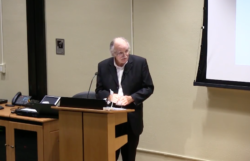The Foreclosure Crisis That Will Not Go Away
 When the financial crisis broke in September 2008, it was widely understood – both in policy-making circles and in popular conversation – that problems in the U.S. housing market were central to the unfolding events. But thereafter, the events themselves took center stage: and the problems of the housing sector, though not forgotten, slipped down the political agenda and off the popular radar. That was a mistake.Problems in the U.S. housing market remain central to our continuing difficulties – problems experienced by people wanting to buy houses, and problems experienced by people who already own one. Economically and politically, a resolution of the U.S. housing crisis remains a key requirement for long term prosperity and, more immediately, for the continuation of a Democratic White House.[1]
When the financial crisis broke in September 2008, it was widely understood – both in policy-making circles and in popular conversation – that problems in the U.S. housing market were central to the unfolding events. But thereafter, the events themselves took center stage: and the problems of the housing sector, though not forgotten, slipped down the political agenda and off the popular radar. That was a mistake.Problems in the U.S. housing market remain central to our continuing difficulties – problems experienced by people wanting to buy houses, and problems experienced by people who already own one. Economically and politically, a resolution of the U.S. housing crisis remains a key requirement for long term prosperity and, more immediately, for the continuation of a Democratic White House.[1]
Economically the current recovery is slow in part because the housing sector remains sluggish. The housing sector remains sluggish because the inventory of unsold houses remains high; and the inventory of unsold houses remains high because the foreclosure crisis refuses to go away. Politically, Obama and the Democrats are losing popular support because unemployment and job insecurity are rife. Unemployment and job insecurity are rife because the economy remains sluggish; and the economy remains sluggish in part because there are still so many foreclosed homes on the market. People are losing their homes in record numbers in contemporary America, and they are doing so now on Obama’s watch, not on Bush’s.
It is true that part of the current foreclosure crisis was inherited by the Obama administration. It is also true that part of it was not.
The Obama administration inherited a foreclosure crisis rooted in the large-scale growth of what were ultimately voluntarily adopted sub-prime mortgages. It now presides over a foreclosure crisis rooted in the large-scale growth of involuntary unemployment in which sub-prime lending plays an ever diminishing part.[2] Indeed the housing sector remains sluggish these days precisely because sub-prime lending has been broadly eradicated – it is now significantly more difficult than it was in 2005 and 2006 to obtain a mortgage[3] – while the general recession that sub-prime lending helped to trigger still eats away at the ability of existing home owners to pay their mortgages, sub-prime or not.
The first foreclosure crisis may well have triggered the second, but even so the two crises are not the same, and they do not deserve the same policy response.
Policy designed by the incoming administration to deal with a foreclosure crisis triggered by sub-prime mortgages is not equal to the task of dealing with a foreclosure crisis triggered by large-scale involuntary unemployment.[4] Moral hazard issues kept the original Obama housing policy (HAMP[5]) policy modest. It kept it modest because the incoming administration had no desire to reward fecklessness and (by implication) penalize responsibility.[6] But people are losing their homes now, not because of their fecklessness but because of the economy’s weakness. Many of those losing their houses in 2010 are innocent victims of a recession which they did not cause. There is no moral hazard issue in their case.[7] They have done nothing wrong; and because they have not, it is time for a housing policy that is addressed to their needs and to their needs primarily. It is time for housing policy to move on.
Twice now, the Congressional Oversight Panel chaired by Elizabeth Warren has made clear the inadequacy of policy to date. In October 2009, it was Warren’s view that “even when Treasury programs are running at full speed, foreclosures are estimated to outpace modifications by about two to one.”[8] Seven months later, the view was the same: “Treasury’s response continues to lag well behind the pace of the crisis…its programs still are not keeping pace with the foreclosure crisis.”[9] Just 168,708 people helped in the first 12 months of the program, as Elizabeth Warren put it,[10] when the rate of monthly foreclosures was nearer to 200,000! Why? For Elizabeth Warren at least, because the administration’s plans seem ‘targeted at the housing crisis as it existed six months ago, rather than as it exists now.”[11]
Sadly, the available data would appear to bear out that judgment – in spite of the minor amendments and new initiatives coming from the Treasury in the wake of pressure from the Congressional Oversight Panel.[12] Data such as this:
- Coverage “For every borrower who avoided foreclosure through HAMP last year, another 10 families lost their homes.”[13] Indeed on the Treasury’s own figures, “of the 6.0 million borrowers who are currently 60+ days delinquent, only 1.8 million, or 30 percent of those in delinquency, are even eligible for HAMP.” [14] The Treasury reported in May that, in the first 15 months of HAMP, among the 1.8 million potential recipients of aid, 1.2 million trial modifications had begun, but that one in four of those had been eventually canceled because people failed to make payments, supply documents or meet eligibility requirements. Mortgages then converted permanently (into the 5 year payment modification program) totaled just 299,092, with another 295,348 conversions on-going.[15] Little wonder then that the Congressional Oversight Panel concluded in April that “foreclosures prevented by HAMP will still likely be eclipsed by the number of actual foreclosures filed in any given year of the program’s existence.”[16]
- Defaults The rate of default on loans modified under HAMP continues to be high.[17] Almost all those who received loan modifications had already defaulted once; and the Treasury recently confirmed that the median ratio of total debt payments to income in households who have received loans modifications remains at a staggering 64 percent![18] (The target ratio for mortgage payments set by the President when launching HAMP in February 2009 was first 38 and then 31 percent.) It cannot therefore be surprising that Fitch Ratings estimates the overall default rate under HAMP as likely to be in the 65-75 percentage range.[19] This, in the context of a housing market in which the supply of foreclosed homes quickened again early in 2010,[20] and in which maybe 5.1 million households (10 percent of the total) will likely see their property values fall below 75 percent of their mortgage value by June.[21] In a world of stagnant/falling house prices and negative equity on this scale, it seems reasonable to expect a further increase in “strategic defaults” – in people walking away from their houses and their mortgages because, though able to pay the mortgage, they see no possibility of ever recovering the capital which they lost as house prices plummeted.[22]
- House prices Nor is this problem going away any time soon.[23] One swallow does not make a summer and one month’s figures cannot do more than illustrate a trend, but look at the data for May. The index of industrial production rose 1.2 percent that month, fueled by a rising global demand for U.S. products. (The index has now clawed itself half way back to its pre-crisis peak from the deep recession it recorded in 2008/9.) Single-family housing starts, by contrast, fell 17.2% in May, as temporary tax relief designed to stimulate house buying ran out. House prices have currently stabilized; but if they fall again, the rate of mortgage default could quicken, pushing the economy back into recession.[24] And house prices may well fall: when interest rates (now so unprecedently low) begin to rise again as they must; when banks begin seriously to unload the more than one million foreclosed properties they now hold; and when the ticking time bomb of teaser rate ARMs[25] kicks in during 2011. “Over $1 trillion in mortgages” predominantly of this kind “will reset during the next three years, and resets will not peak until November 2011.”[26] There can therefore currently be no guarantee that the Obama administration, having weathered two stages of this foreclosure crisis, may not yet face a third.
- Delinquency There is some good news out there. The rate of mortgage delinquency appears for the moment to have stabilized,[27] and the number of mortgage loans that nationally were 90+ days overdue fell slightly in March 2010, down to 9.54 percent from 9.67 percent in December 2009. The bad news that accompanies the good, however, is that this lower percentage still represents nearly one U.S. mortgage in ten: some 4.9 million borrowers – 1.2 million more than in March 2009.[28] The number of loans that were 30+ days overdue or already in foreclosure was actually slightly up in March 2010 – up to 14 percent of all mortgage loans from 12 percent a year earlier, and now involving 7.3 million households.[29] To quote the Oversight Panel again: “At the end of the first quarter [of 2010] about 9.4 percent of borrowers were overdue on payments but not yet in foreclosure, and about 4.63 percent were in the foreclosure process.”[30] Delinquency, foreclosure and eviction are all separate processes, of course, each one of which can take many months – so that many of those now in foreclosure are still in their homes: but how do you measure the stress and the pressure of that on the reportedly 2.8 million home-owners who received a foreclosure notice in 2009![31]
It is not that the Obama administration has been totally inactive or totally ineffective in its housing policy. On the contrary: on the demand side for housing – on the plight of people wanting to acquire a mortgage – the administration’s record is clear and broadly positive. As the Congressional Oversight Panel have it:[32]
“It is likely that government intervention in the housing market, such as the homebuyers tax credits, support for Fannie Mae and Freddie Mac, a large increase in FHA insurance underwriting, and Treasury and Federal Reserve purchases of mortgage-backed securities, as well as Federal Reserve policy aimed at keeping interest rates low, have fostered increased demand for home purchases by making them more affordable and by reducing the cost of mortgage finance.”
But what is also clear is that “some of those government interventions in the housing market are being scaled back or eliminated”[33] at the very time when the assistance afforded under HAMP to people who already have a mortgage but can no longer afford to maintain it is proving to be fundamentally inadequate to the task faced. Under the existing HAMP, what you get is temporary help with your payments. What you don’t get is help with reducing the amount you have borrowed. The help you get is also only temporary – even the “permanent” modification lasts only 5 years – and still leaves you servicing large quantities of debt: “the typical post-modification borrower still pays about 59 percent of his total income on debt service”[34] according to the Congressional Oversight Panel – even more, as we just saw, according to the Treasury.[35] Moreover, if you were underwater when you applied for the temporary help – if the current value of your house had fallen to less than the size of your mortgage – then any help you get under HAMP will still leave you underwater. Currently one American household in four is underwater.[36] In Nevada, it is almost three houses in four![37] The intention behind HAMP was laudable. Its design and implementation has been less so: as Elizabeth Warren put it to Judy Woodruff, “it’s as if we had a boat that’s taking on gallons of water, and they’re trying to bail it with a teaspoon.”[38]
The present housing situation is intolerable. It is morally intolerable. It is economically intolerable, and it is electorally intolerable. Innocent people are getting hurt. Economic recovery is being retarded. Support for progressive politics is being lost.
Which raises the question: why is this being allowed to happen? Is anyone in the White House awake on this issue? Tim Geitner and Larry Summers may not get it, but somebody needs to. If only to ensure that the Democrats hold on to that particular house for more than one presidential term, somebody working in the White House needs to design a program that will actually help, and needs to design that program in a hurry.[39] The Democratic Party likes to present itself as the champion of the dispossessed. There cannot be a much more serious form of dispossession in modern American than the dispossession of your house. Can someone please tell the administration that it is time to keep all Americans in their homes, including Barack and Michele Obama in their temporary one. Because if policy does not change quickly and in the right direction, the first family may be back in the private housing market far sooner than either they or their supporters think desirable – and that would be an appalling waste!
[1] This is the third in a series of updates on this web site on the foreclosure crisis. See also https://www.davidcoates.net/2010/05/07/the-foreclosure-crisis/
https://www.davidcoates.net/2010/01/30/the-housing-policy-in-2009/
[2] Or maybe plays no part at all, since according to the Congressional Oversight Panel Report of April 2010, “nearly all subprime mortgages have already reset, meaning that the foreclosure problem has moved from a subprime to a prime problem.” Congressional Oversight Panel, Evaluating Progress of TARP Foreclosure Mitigation Programs, April 2010, p. 113. The report is available at
http://cop.senate.gov/reports/library/report-041410-cop.cfm
[3] Maybe a third of those obtaining mortgages in 2005-6 would not now qualify for a mortgage; and not just here in the U.S. This morning’s London Observer carried a story headed “mortgage lender refuses mortgage application because the road’s busy and there’s a restaurant next door”, reporting that the Abbey Building Society was now so strict with its lending criteria that it was currently refusing a mortgage on a property on which it had happily lent only four years before – to a couple to whom it has also previously happily lent!
[4] As the Congressional Oversight Panel report put it, ‘It has generally been difficult for unemployed borrowers to qualify for HAMP because affordable monthly payments for people without a paycheck are usually too low to make economic sense to the investor….unemployment is a major driver of delinquencies, foreclosures, and consequently, home values. Unemployed borrowers without significant savings are unlikely to be able to pay their debt services regardless of what loan modifications they receive.” (op.cit, pp. 18 & 134)
[5] HAMP is the acronym for the foreclosure relief program announced by President Obama in February 2009 (the Home Affordable Modification Program).
[6] Launching HAMP in February 2009, the President said this. “I want to be very clear about what this plan will not do. It will not rescue the unscrupulous or irresponsible by throwing good taxpayer money after bad loans. It will not help speculators who took risky bets on a rising market and bought homes not to live in but to sell. It will not help dishonest lenders who distorted the facts…and it will not reward folks who bought homes they knew from the beginning they would never be able to afford….This plan will not save every home.” The full text is at http://www.whitehouse.gov/the-press-office/remarks-president-mortgage-crisis
[7] Not that you would necessarily know that if you listen to certain bankers: David Lowman of JP Morgan Chase, for example, telling the House Financial Services Committee (April 2010) that “principal reduction could reward households for consuming more than they can afford.” That – opposition to using just a small amount of TARP money to help struggling home owners, from someone employed by a bank bailed out by TARP money when it was in trouble, and bailed out to the tune of $25 billion – seems deeply offensive to me! (full details at https://www.davidcoates.net/2010/01/30/the-housing-policy-in-2009/
[8] Quoted in The New York Times, October 10, 2009
[9] Evaluating the Progress…op.cit., pp. 3 & 97
[10] Ibid, p.3
[11] Quoted in The New York Times, October 10, 2009
[12] A whole string of baby steps that include a Second Lien Program as part of HAMP, an extension of HARP (the non-TARP financed Home Affordable Refinance Program facilitating the resetting of GSE-guaranteed mortgages), changes to HAMP to allow temporary help to unemployed homeowners, and new conditions and incentives to HAMP servicers to write down principal. Plus, in February 2010, a Hardest-Hit Fund to help mortgage modification in the 5 hardest-hit states (including Harry Reid’s Nevada).
[13] Evaluating the Progress…op.cit., p. 3
[14] Ibid, p. 66. Eligibility requires that you be: the owner-occupant of a one-to-four unit house; have an unpaid mortgage of up to $729,750; have a first-lien mortgage begun before January 1, 2009; have a monthly mortgage payment greater than 31 percent of your gross pre-tax income; and be able to document financial distress making you actually/likely to be delinquent on your mortgage payment. (see Evaluating the Progress…, p. 65)
[15] James Hagerty, “Loan Aid Leaves Some Worse Off”, The Wall Street Journal, May 18, 2010. The Treasury calls the loan modifications “permanent” but in truth they last at most five years.
[16] Evaluating the Progress…op.cit., p. 68
[17] “It is generally too early to draw firm conclusions about the performance of HAMP permanent modifications. The initial signs are not encouraging, however.” (Evaluating the Progress…op.cit., p. 60)
[18] James Hagerty, ‘High Defaults seen on Modified Loans”, The Wall Street Journal, June 6, 2010
[19] ibid
[20] “Mortgage analysts at Barclays Capital in New York estimated that banks and mortgage investors held a total of 645,800 foreclosed homes in January, up 4.6% from 617,286 a month earlier. According to Barclays, the supply peaked at around 845,000 in November 2008 and then declined through 2009….Barclays project that the supply of foreclosed homes will rise to about 733,000 in April, and then begin to decline again gradually. Foreclosed properties now account for roughly a fifth of all homes listed for sale nationally.” (The Wall Street Journal, March 19, 2010)
[21] This estimate was by First America, cited in Mort Zuckerman, “America must help its homeowners”, Financial Times, March 5, 2010. The Congressional Oversight Panel observed that “the typical HAMP-modified mortgage has a balance 25 percent greater than the value of the underlying home.” (Evaluating the Progress…op.cit., p. 4)
[22] See Evaluating the Progress…op.cit., pp. 130-31 for more detail.
[23] As Evaluating the Progress…: “While several indicators of housing market health have shown improvement in recent months, others are trending in the opposite direction. House pricing levels are crucial for foreclosure prevention, as default rates have a strong negative correlation with changes in housing prices from the time of financing. Depressed housing prices contribute to negative equity, which impedes refinancing and encourages strategic defaults. A low recovery of housing prices means that foreclosures and default rates are likely to remain elevated for some time into the future, and also threatens the sustainability of HAMP permanent modifications.” (ibid, pp. 6-7)
[24] Justin Lahart & Emmeline Zhao, “Industry Speeds Recovery, And Housing Slows It Down”, The Wall Street Journal, June 17,2010
[25] ARMs are Adjustable Rate Mortgages
[26] Evaluating the Progress…op.cit., p. 112. “Today, more than three in four option ARMs are under water, according to Fitch Ratings, and one-third have a combined loan-to-value ratio of over 150%.” (The Wall Street Journal, March 29, 2010
[27] “The latest data indicates that February had the lowest year-over-year increase in foreclosure starts in four years,” Evaluating the Progress…op.cit., p. 123.
[28] Nick Timiroas, ‘Mortgage Delinquencies at FHA Show SlowDown”, The Wall Street Journal, June 7, 2010
[29] James Hagerty, ‘Delinquent Loans Plateau at High Level”, The Wall Street Journal, May 20, 2010
[30] Evaluating the Progress…op.cit., pp. 123-28
[31] Ibid, p. 3
[32] Ibid, p. 102
[33] Ibid, p. 102
[34] Ibid, p. 4
[35] See point 2 Defaults in the text
[36] ‘The average underwater borrower today owes about $70,000 more than their home is actually worth.” (Zach Carter, Home Underwater? Walk away from Geitner’s Perverse ‘Homeowner Relief’ Plan, posted on Alternet, February 10, 2010: available at http://www.alternet.org/story/145551
[37] The significance of the Nevada figures is best explained by Robert Kuttner, in his Harry and the Homeowners, posted on Huffington Post, May 2, 2010: available at http://www.huffingtonpost.com/robert-kuttner/harry-and-the-homeowners_b_560408.html. The Congressional Oversight Panel Report dedicated a separate appendix to the 5 states in greatest trouble (Michigan, Arizona, California, Florida and Nevada) and quoted forecasts of house prices there not fully recovering lost ground until 2030! (Evaluating the Progress…, p. 146)
[38] http://dailybail.com/home/elizabeth-warren-grills-geithner-criticizes-treasurys-forecl.html
[39] There are some pretty good ideas canvassed on page 20 of the Congressional Oversight Panel Report, including loans on which no interest is paid until you are working again; or housing vouchers to supplement unemployment insurance – different ways of ensuring that, though you lose your job, you keep your home.
David Coates holds the Worrell Chair in Anglo-American Studies at Wake Forest University. He is the author of Answering Back: Liberal Responses to Conservative Arguments, New York: Continuum Books, 2010.
He writes here in a personal capacity.






David Coates: Doing Two Things at Once: Jobs and Housing as Routes Out of Recession? | PUII - News Blog says:
[…] aid provided to struggling house owners by this administration remains too little, too late and too uncelebrated. The new aid now being proposed was characteristically tucked away as a minor detail in the long […]
David Coates: Doing Two Things at Once: Jobs and Housing as Routes Out of Recession? says:
[…] aid provided to struggling house owners by this administration remains too little, too late and too uncelebrated. The new aid now being proposed was characteristically tucked away as a minor detail in the long […]
WeMustChange » Blog Archive » David Coates: The White House and Your House: Policy Inertia and Organizational Resistance in the On-going Crisis of American Housing says:
[…] crisis as it existed six months ago, rather than as it exists now.” was how Elizabeth Warren earlier described it ) – such that even now policy is primarily focused on lowering the costs of […]